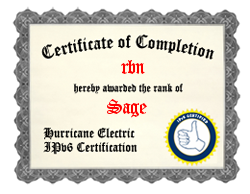yadifa DNS master with Hurricane Electric slaves
this explains in short terms how to setup a yadifa DNS server which is backed up by Hurricane Electrics free DNS service.
installing yadifa
yadifa is availabla packaged for some distributions, with slackware you have to install it by compiling it from the script found on SlackBuilds.org.
at the time of writing, SBo is in freeze awaiting the release of Slackware 15. the version available for Slackware 14.2, 2.4.0 is a bit outdated. meanwhile the maintainer sergej has fixed the script for -current and i took the liberty to update this to 2.5.3 in my own repository of slackbuilds.
after you installed yadifa, you have to customize the config of yadifad
and yadifa (the control program).
configuration
following are sanitized and commented versions of my configuration. yadifas reference manual is excellent, in doubt just look things up there!
yadifad.conf
this is the configuration of the nameserver daemon.
<main>
allow-control yadifa-control
keys-path /var/lib/yadifa/zones/keys
data-path /var/lib/yadifa/zones
log-path /var/log/yadifa
pid-file /var/run/yadifa/yadifad.pid
max-tcp-queries 100
tcp-query-min-rate 6000
answer-formerr-packets yes
serverid ns.example.org # change to the FQDN of your nameserver
user yadifa
group yadifa
statistics no
statistics-max-period 60
version "000"
</main>
<acl>
# limit access to control functionality to this key (defined further down and ip)
yadifa-control key "controller-key";127.0.0.1;::1/128
# ACL to limit AXFR and IXFR to Hurricane Electric servers
he-dns 216.218.133.2;2001:470:600::2/128
</acl>
# key to secure access to the control functionality
<key>
name "controller-key"
algorithm "hmac-md5"
secret "longsecretstring"
</key>
<control>
enabled true
</control>
# identification string of your nameserver, FQDN should suffice
<nsid>
ascii "ns.example.org"
</nsid>
<rrl>
responses-per-second 5
errors-per-second 5
slip 10
log-only off
ipv4-prefix-length 24
ipv6-prefix-length 56
enabled yes
</rrl>
# log to syslog, facility "local6" and include PID in logged messages
<channels>
syslog syslog local6,pid
</channels>
# just log everything
<loggers>
database info,warning,err,crit,alert,emerg syslog
server info,warning,err,crit,alert,emerg syslog
system info,warning,err,crit,alert,emerg syslog
zone info,warning,err,crit,alert,emerg syslog
</loggers>
# zone to serve, this section can be included multiple times for different zones
<zone>
# domain name of the zone
domain example.org
# zone file
file "masters/example.org.zone"
# master or slave zone
type "master"
# allow transfers for this ACL
allow-transfer he-dns
# HE uses two different servers one for transfers (slave.dns.he.net), one
# to receive notifications (ns1.he.net). this sets up the right target
# for notifications and disables the default behavior to
# send it to the servers allowed for transfers.
# notify this server about changes
notify 216.218.130.2
# disable notifications for servers in the transfer ACL
notify-auto false
</zone>yadifa.conf
this is the configuration of the control-client-program
<yadifa-ctrl>
server 127.0.0.1
tsig-key-name "controller-key"
</yadifa-ctrl>
<key>
name "controller-key"
algorithm "hmac-md5"
secret "longsecretstring"
</key>zone files
now that the daemon configuration is in place, you can put the zone data
into /var/lib/yadifa/zones/masters/example.org.zone. how to write a
zone file is left as excercise to the reader :^)
afterwards the daemon can be started (on slackware) with /etc/rc.d/rc.yadifad start. don't forget to put it into rc.local and rc.local.shutdown to have it start/stop on system boot and shutdown.
Hurricane Electric setup
if you are a HE IPv6 certification holder or have a tunnelbroker account, you can also use HEs free DNS service.
before you can add replication to Hurricane Slectric servers, you have to setup a few things:
- add Hurricane Electric nameservers
ns[12345].he.netto your domain at your registrar - add the same nameservers as NS records in your zone file
if you've done this and changes have applied everywhere, log into the DNS service and choose "Add a new slave". in the following form insert your domain name and your nameserver as master. if you have further restricted transfers with a key, also insert that. after you click on "Add Slave!" a few sanity checks will be performed and your slave zone is added (it might take a few minutes for the initial transfer to happen).


![[ Celebrate 40 years of GNU! ]](https://www.gnu.org/gnu40/GNU40_badge-sm.png)